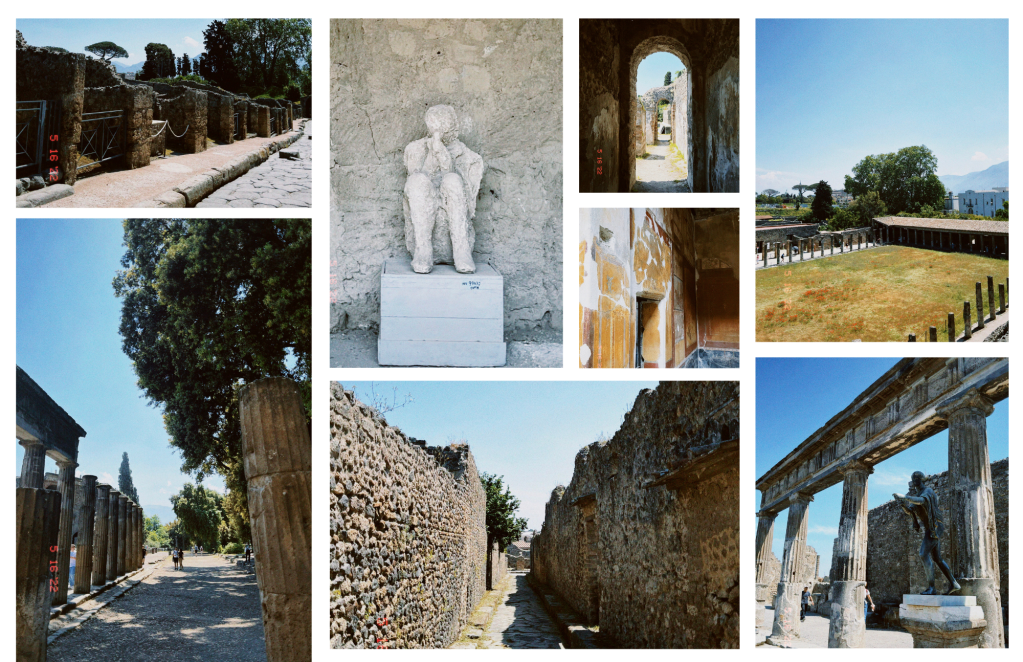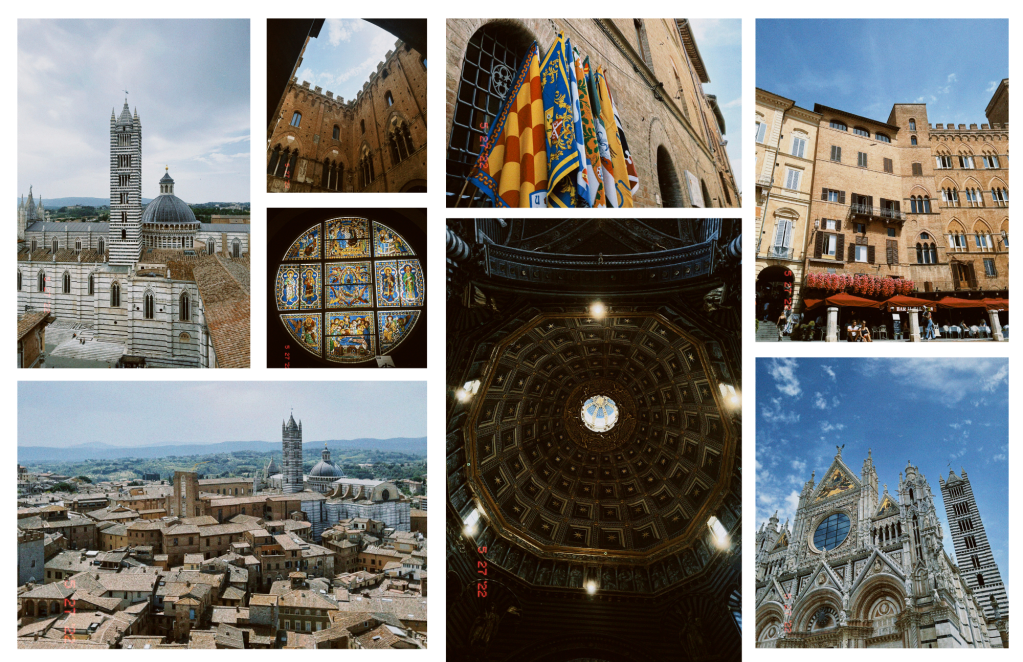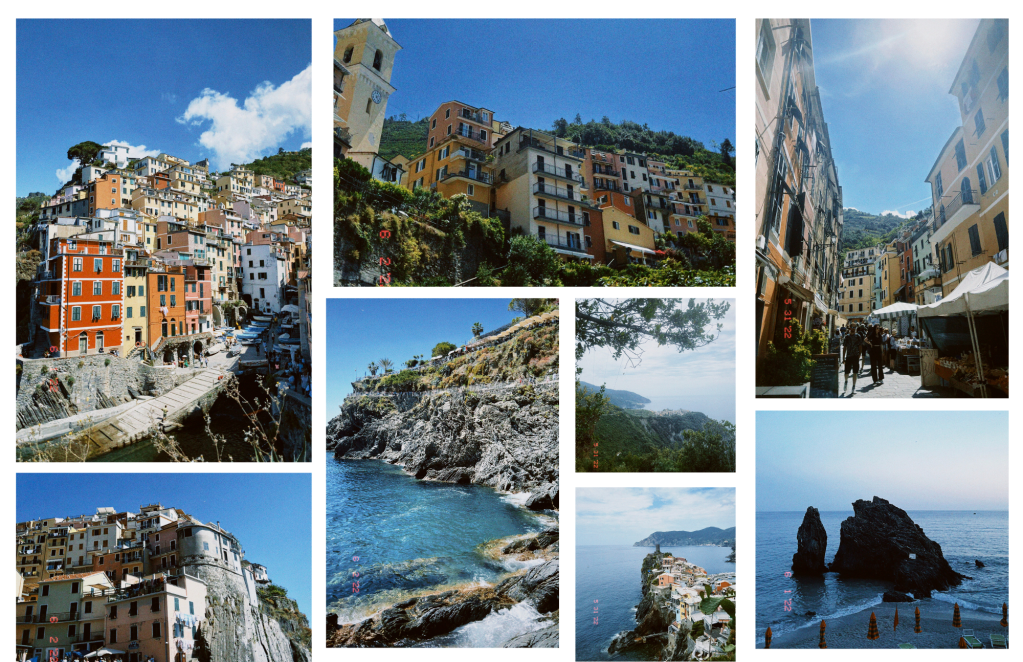
Hello! My name is Emma Cairo-Benoit, and I am currently a junior at Florida International University studying Public Relations Advertising and Applied Communications. In the future, I plan to work in the entertainment industry as a social media manager. Since, the beginning of my college career, I have dreamt about studying abroad, and I am so happy to finally be able to achieve that dream of studying the history and culture of Italy.
Roma as Text

Cammina Secondo la Fede
By Emma Cairo-Benoit of FIU in Rome, 9 May – 23 May 2022
Before I could even speak, Catholicism was ingrained into me. While living in my grandparents house as a child my grandfather would carry me around the house and would always stop in front of a small silver plaque with the image of the Virgin Mary and the baby Jesus, there he taught me how to do the sign of the cross. I was baptized at the same church where I would attend Catholic school for twelve years of my life and then leave to continue my education at an all-girl Catholic high school run by nuns. I have had my moments, in my twenty years of life as a Catholic, of doubt and uncertainty, along with some contradictory thoughts on Catholic beliefs. However, I have always found solace in my faith and in the wonders of certain aspects. Being able to visit some of the most important churches in Catholicism was a transforming moment for me. Standing in front of the steps that Jesus walked on to face his fate given to him by Pontius Pilate as he was sentenced to the crucifixion at the Santa Scala was a moment I never thought I would be able to witness. For years I have heard the same story in theology classes and during Mass at Holy Week services where Jesus was betrayed by his apostle Judas and he was then arrested and flagellated before being brought to Pontius Pilate where the crowd then got to choose between Jesus and Barbbarus on whom to set free. The crowd chose to set Barbbarus, a convicted murder, free and Pontius Pilate then sentenced Jesus, convicted of treason, to be crucified. Seeing not only the steps Jesus walked on but a piece of the column where he was flagellated was such a solemn moment for me. Rome holds so much history not only in the foundation of the city and the architecture, but in Catholicism as well. People that travel and pilgrim from all over the world to see a glimpse of relics or to visit the capital of the religion find peace and a sense of clarity in finally being able to see for themselves the true faith.
Pompeii as Text

A City Frozen in Time
By Emma Cairo-Benoit of FIU at Pompeii, 16 May 2022
On August 24, 79 BCE, Mount Vesuvius erupted over the city of Pompeii burying it in volcanic ash and debris leaving the city to be preserved and forgotten about until the 16th century. The city founded by the Greeks and then taken over by the Romans was known for being extremely ahead of its time and a commercial city. Pompeii is often compared to the modern New York City of its time with people constantly traveling, the scandalous yet enthralling sexual industry, the class system and social scene. When Mount Vesuvius erupted many fled the city to safety but others thought they had more time and chose to stay in the city. Approximately 2,000 people were killed in Pompeii because of asphyxiation of the toxic gases of the volcano, they were then covered in the ash that later hardened leaving the city exactly how it was at the time of the eruption. When the city was rediscovered in 1748 by engineering surveyors, they found empty cavities that seemed to be in the shape of humans so they filled the spaces with a plaster mold and then were able to find the remains of the individuals that perished in the fall of Pompeii. To this day only two thirds of the city of Pompeii has been excavated. In 2010, the Schola Armaturarum, the old gladiator barracks collapsed due to the pressure put on them by the physical mass of the unexcavated city pushing up against them. Most of the funds given to the city today are allocating towards preserving what has already been uncovered, but the complete excavation continues day by day to fully uncover the remains of the lost city.
Tivoli as Text

La Simplicita della Natura
By Emma Cairo-Benoit of FIU in Tivoli, 13 May 2022
For me, nature has always been how I most connect to God and to this world. The beauty of a sunset, an open field, the greenery of trees, fresh flowers, or a wide mountain range gives me one of the most fulfilling feelings seeing the raw beauty this earth has to offer. Tívoli was the first time in Italy where I was able to have that sense of peace in nature. Hadrian’s Villa was built as a retreat for him from the Palatine Hill in Rome. Hadrian had Spanish background therefore he was unpopular in Rome because of his Spanish accent and he decided to continue his rule as Emperor in his villa in Tívoli. He was the first emperor to rule away from the city. In the villa, Hadrian’s study was constructed as a moat with a private room surrounded by a water defense and an open patio in the center. The gardens hill overlooking the mountainside and city or Tívoli also allow you to take in the simplicity of the town compared to the loud bustle of Rome. While the villa was created to be an extravagant getaway for the Roman emperor it still leaves a lasting impression as a way to be more connected with the earth. After Hadrian’s Villa, at the end of the day trip to Tivoli, going down the valley of hell in the mountain was such a tranquil experience for me. Being fully surrounded by the trees, greenery, and flowers, as well as climbing into Neptune’s Grotto seeing the crystal clear water flowing out of the mountain felt grounding in a sense and made me fully realize the need for an escape from the business of city life into the peace and tranquility of the nature in the country.
Firenze as Text

La Primavera
By Emma Cairo-Benoit of FIU in Florence, 23 May – 31 May 2022
Sandro Botticelli’s Primavera painting, displayed in the Uffizi Gallery in Florence is said to be one of the most popular and controversial paintings in the world. Standing in the presence of the painting’s beauty I was able to understand the world’s captivation of one painting. The immense detail in Botticelli’s work left me wonderstruck as I tried to take in and analyze every inch of the artwork. From the hidden sexual innuendos to all the plants and greenery in the landscape, your eyes don’t know where to fall when looking at the masterpiece. The depiction of the women in Greek mythology each represent a different value but together create a sense of harmony across the entire painting. Zephyrus being taken from the forest by a nymph with flowers spilling out of her mouth, Flora the goddess of spring appears to be pregnant as she throws flower petals from her arms, Venus in the middle chastely covered with a red shawl that drapes to represent a sexual innuendo, and the three graces dancing in a circle with their hands joining all represent a celebration of love, peace, and prosperity. There is also said to be 500 different plant species in the Primavera which additionally demonstrates the impeccable attention and intelligence of Bottecelli. Seeing this painting in person does not compare to seeing it on a projector in a classroom or on a computer screen. It truly takes your breath away standing in front of it and figuring out the meaning behind each element of the painting makes it even more memorable.
Siena as Text

The Stengal Moment
By Emma Cairo-Benoit of FIU in Siena, 27 May 2022
The Stengal moment, as it was taught to us, is a moment in which you are so overcome by a place, an artwork, a monument, or the beauty and meaning behind something. I have been searching, or rather, hoping to have that Stengal moment the entire trip. I finally had that moment in the cathedral of Siena. To me, the simplicity of the dome with the blue squares and gold star design along with the gold angels around the oculus of the dome was the perfect contrast to the eccentric designs throughout the rest of the church. However, the thing that led to my Stengal moment was the mosaic artwork on the floor of the cathedral, more specifically the piece that depicts the Massacre of the Innocents. At the time of Jesus’s birth King Herod of Judea ordered the execution of all male children two years old and younger in the area of Bethlehem because he feared the threat of The Messiah’s birth. When we learned that this piece in particular was not just created to display the church’s wealth, but in fact it was created as a contemporary piece to represent the issues in the city going on at the time. Relating the Slaughter of the Innocents to the recent mass shooting in Uvalde, Texas, resonated with me extremely. The United States is facing a major issue as we continue to see a consistent rise in mass shootings, our society’s version of the Killing of the Innocents. The shooting at Uvalde was the second mass shooting in the span of two weeks, and 21 children and teachers were murdered. Being out of the country when it occurred made the news seem out of reach, but standing over the mosaic looking at an artistic representation from over 500 years ago that still relates to what our world is facing today really set in fact that there needs to be change. Artwork such as the mosaic of the killing was created to remind people of the wrongs in order to change for the better. Understanding the deeper meaning behind the mosaic in the cathedral was incredibly moving and finally allowed me to have that Stengal moment I have been waiting for.
Cinque Terre As Text

The Five Lands
By Emma Cairo-Benoit of FIU in Cinque Terre, 30 May – 3 June 2022
While on the Grand Tour, travelers would arrive to Cinque Terre and spend a few days there reflecting on their travels and all they have learned and accomplished throughout their tour. After learning about this tradition, I took the time in Cinque Terre to do the same. Being in the mountain and the calmness of the beach was a relaxing contrast to the restless cities of Florence and Rome. Living in the Santuario di Savorie for a few days was a great way to disconnect, and speaking directly to some of the travelers there that were completing their own Grand Tour was a humbling way to compare the experiences. For the past couple of weeks I have felt very caught up in the movement between each city and what the next day will bring, but while hiking in Cinque Terre from mountain to mountain with nothing but the sounds of the birds, the rustling of the trees, the wind, and the streams of the water it was a great opportunity to think about how thankful I am for this amazing experience. I had my moment of, “I actually made it to the place I had dreamed about, and it’s all coming to an end in a few days.” After the hike, ending in Manarola, a few students and I went to the rocks and jumped into the Mediterranean Sea, and while swimming with the people who were practically strangers a few weeks ago I realized just how lucky I am to share this experience with them. This small period of rest and relaxation prepared me for the final leg of the Grand Tour and reminded me to soak up and appreciate every last minute.
Venezia as Text

Row, Row, Row Your Boat
By Emma Cairo-Benoit of FIU in Venice, 3 June – 7 June 2022
Started in 1974, the Vogalonga Regatta is a non-competitive row boat race along the canals of Venice that began as a peaceful protest against wave damage caused by motor boats, and lagoon degeneration. This celebration takes place once a year and brings together Venetians and enthusiasts from all over the world. Rowers from across the globe travel to Venice each year to be part of the Regatta and participate in any style of rowboat in teams or solo. While the race is non-competitive, spectators line the waterways and bridges in Venice to cheer on teams showing support and enthusiasm for participants. The good-spirited fun is evident in the rower’s teams cheers and singing as they row down the grand canal and wave to viewers. Walking down the Ponte Rialto on June 5th, the sudden sounds of cheers and large crowds on the edge of the bridge stopped me and my classmates as we were strolling through the city. We stopped to look over the bridge and we’re stunned to see so many rowboats in the canals. In the brightest shades of pinks, neon yellows, red stripes, and even Franciscan monks rowers made their way down the canal waving to all as we joined the crowd in cheering for each boat that passed. We had no idea what was occurring, but after a quick google search I learned the quick history on the Regatta and we were fully able to emerge ourselves in the Venetian tradition. This moment of watching and cheering alongside the crowds was truly one I won’t forget as I felt the enthusiasm and energy all around me.